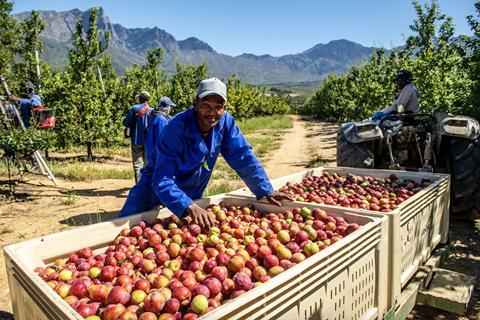Export volumes are forecast to rise by 6 per cent compared to the previous season, with nectarine exports expected to grow by 18 per cent to 12.26mn cartons thanks to favourable conditions and higher-yielding orchards

South African producers are optimistic for a strong stonefruit season on the back of increased production, favourable weather and improvements to address long-running logistical issues.
Good weather during the winter and blossoming periods has led to desirable fruit set and fruit quality across most production regions, industry body Hortgro has reported.
Overall, export volumes are forecast to rise by 6 per cent compared to the previous season, indicating a healthy and balanced supply across all stonefruit categories.
Nectarine volumes are expected to recover to normal levels following a challenging 2024/25, and while the country experienced a cold winter, rainfall was relatively low and dams are set to provide enough water for the upcoming warm and dry summer.
This should result in good eating quality and storability, Hortgro noted.
Nectarines continue to be a ”standout category” for the South African stonefruit sector, with growers investing in orchards and new varieties.
That has led to a 26 per cent increase in total nectarine hectarage over the past five years, and the ongoing adoption of higher-yielding varieties will support further export growth in the years to come.
According to Hortgro’s forecasts, overall nectarine exports for 2025/26 are set to grow by 18 per cent to 12.26mn cartons, thanks to favourable conditions for early varieties and higher-yielding orchards.
Plum exports are projected to increase by 3 per cent to 15.35m cartons, with peaches up 3 per cent to 1.94m cartons.
The only crop set to decline is apricots, which is forecast to drop 3 per cent to 720,000 cartons.
“We are cautiously optimistic about the season ahead,” said Charl Herbst, chairman of stonefruit at Hortgro.
“Early indications are looking positive, with good volumes in the market, high-quality fruit and stable prices.
”Eating quality is excellent and export volumes will definitely rise if growing conditions stay the same as they are now,” he outlined.
Confidence is increasing among South African growers thanks to breakthroughs in addressing two key issues that have held the sector back over the past three years.
Delays at ports have been reduced thanks to new investment in infrastructure and plans by new management to address longstanding problems, and while there is still room for further productivity improvements, port efficiency is expected to be significantly improved this season.
On farms, due to challenges with load shedding in previous years, growers have been installing solar technology.
Although load shedding seems to be in the past now, the move has also given the sector a further sustainability boost.
Producers believe there is much to be excited about when it comes to global export potential.
Demand in the UK and Europe remains strong, and exporters are expecting a smooth season.
In the UK, that will be supported by a marketing plan that includes off-fixture displays in the top 100 Morrisons stores, an advert in Sainsbury’s magazine, trade PR, and feature articles.
There will also be further consumer-facing activity in the form of three new recipes created by South African chef Reuben Riffel, social media posts across Instagram, Facebook and LinkedIn, and a collaboration with foodie influencer Izabella Jakubec.
Beyond the traditional markets, South Africa has high hopes of becoming a significant supplier to the Chinese market in the long term after access was granted for its stonefruit in October.
There is also optimism that despite president Donald Trump’s tariffs, there is a rosy future for South African stonefruit in the US.
“Although recent tariff adjustments have been implemented, we remain committed to continuing our exports to the United States,” said Herbst.
It all adds up to a very upbeat picture after a difficult few years for the industry.
“Investment is currently going into planting, replacing orchards, new varieties, building better packhouses with new technology, and improving cold storage facilities,” he added.
“There are certainly still things to improve upon, but if you look at how it’s going, it’s a very positive outlook.”



